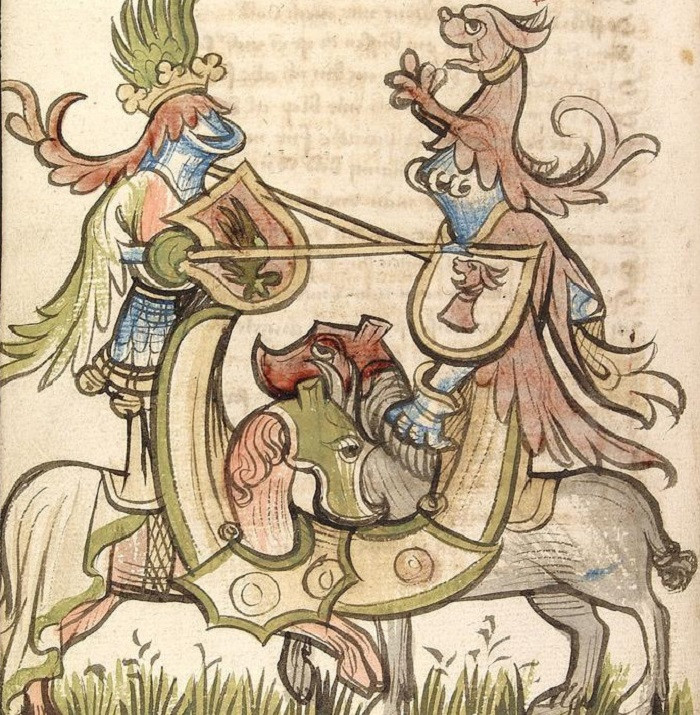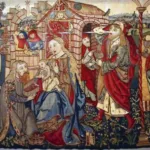If we talk about medieval tournaments and jousts, it is not difficult for us to remember the numerous films that have recreated this famous medieval practice. In fact, toWhen evoking the Middle Ages, it is very likely that tournaments and jousting are the first thing that comes to mind But what do we know about this medieval practice? What is true and what is legend?
In this article we invite you to take a brief tour of one of the most popular entertainments of the Middle Ages, and learn better about its origins, characteristics and function.
Medieval tournaments and jousts: differences and similarities
First of all, it is necessary to clarify the differences between these two concepts, because they are not the same activity. Although both words are used interchangeably today, this was not the case in the Middle Ages It is true that jousting used to be held within tournaments, whose meaning is much broader; However, there are a series of differences that we will point out below.
Tournaments or mock battles
The tournaments are documented from the 11th century onwards, but there are clear indications that, prior to that date, similar activities were already held in medieval Europe. The word tournament has, most likely, a French origin: it may come from tournoi, derived from the verb tourner (to turn, to turn). This etymology can give us a clue as to what this medieval activity consisted of; It may refer to the turning of knights in the middle of battle, when they were forced to turn their horse around to face the enemy again.
The tournaments, indeed, They were recreations of battles, in which two “armies” of knights faced each other Originally, they took place in the so-called champ clos or closed field, but later they began to be exercised outdoors, near sufficiently important cities. After the tournament was held, the second part of the celebration was held in some main place in the city, which was none other than the banquet and dance.
Jousting or single combat
The main difference between a tournament and a joust is that the latter was a single combat; that is, a fight between two knights.
Another difference is that, while in tournaments the main weapon was the sword, Only the spear was allowed in the jousts The jousting spear was made of light wood, to facilitate the horse’s trot and the combatant’s agility. In the 14th century, a vamplate was added, an oval piece of metal that served to protect the hand.
Generally, the joust was one of the spectacles offered within the tournament It was usual to celebrate them the day before the main great battle, and prizes were awarded to knights who had stood out, whether for their bravery, their skill or for anything else that had earned the admiration of the public.

The admiration of the ladies
Although this has been idealized in later literature (especially that of Romanticism), it is true that The ladies were the main audience of the jousts Let us not forget that this type of practice served the knight to demonstrate his skill, so one of the objectives, within the framework of medieval Courtly Love, was to impress his lady.
It was not at all unusual for the combatants to wear a garment, a gift from the lady in question, when they went out to the fray. In addition to giving them luck, it was a proof of love and devotion, which the interested party received with great pleasure.
The important role of servants
The military equipment that the knight was carrying when entering the fray was incredibly heavy, so we can imagine that, if he was unfortunately knocked off his horse, he would not be able to stand up.
Here the servants, who remained very close to their masters, enter the gap left by the two protective palisades. His mission was very delicate and, of course, extremely important: When their master fell to the ground, they had to go out and drag him off the list to avoid possible death (the opponent’s horse, or his own, could crush him). Their mission was also to go out and help the knight in case he lost his balance and swung dangerously on his chair.
As we see, the role of these servants was crucial for the proper development of the fair.
Tournaments and jousting were in fashion, but they were not to everyone’s taste.
Indeed; Despite being one of the most common entertainments in the Middle Ages, Not all social groups were in favor of the practice of these activities The Church, for example, was always very critical of them. Let’s see it below.
The tournaments (like the jousts) had a recreational character, never military (despite being, technically, battles). However, it was not unusual for both tournament and joust to end in excessive bloodshed. The Church, in general, was absolutely against these activities; Many priests refused to give Christian burial to the knights who died practicing them, and even threatened them with excommunication.
In 1228, Pope Gregory IX issued a bull in which he spoke out against tournaments And it’s not like the kings were very amused either. King Henry II of England, for example, signed edicts against these activities, so many knights were forced to move to France to continue participating in them.
Richard the Lionheart was more understanding (or simply saw it as a good deal). According to the medieval chronicler Jocelin of Brakelond, tournaments and jousting were recovered in England after the return of the monarch from the Holy Land. Indeed, once the crown was recovered, Ricardo began to grant licenses to hold tournaments and jousts. This meant that, If you wanted to practice these activities, you had to pay
Roger de Hoveden, another of our medieval chroniclers, gives us valuable information in this regard: a duke paid 20 pieces of silver; a baron, 10 pieces; a knight with lands, 4; and, finally, those who were not holders of any fief, only paid 2.
The armament of every good knight
Only knights could participate in tournaments and jousts. There were, certainly, some exceptions, as is the case in England, where (as we have already seen with Richard the Lionheart’s tariff) men who did not belong to the status of the nobility were sometimes accepted. Be that as it may, when entering combat, whether in a tournament or a joust, the knight had to be properly equipped. Not only his honor was at stake, but probably his life as well
Knightly clothing
The Middle Ages is a very long period and, as such, fashions changed. However, we will try to sketch a summary of the gentleman’s clothing.
It was important to protect the head from the friction of the chain mail using a padded fabric bonnet, as well as the chin (with the barber), the neck (with the ruff) and the nape of the neck (with the neck cover). Then, the tournament helmet was placed on the head, carefully tied with ribbons.
The tournament helmet was lighter than the war helmet and had a conical shape at the top to prevent blows. Just had a tiny opening at eye level so the heat was unbearable and breathing was difficult.
It was common for the knight to wear a gambeson under his breastplate, a type of padded doublet that helped stop blows. To protect the legs there were two pieces of iron, one that covered the lower part, and another for the upper part. But perhaps one of the most important elements was the chain mail, a type of tunic made with interlocking steel rings, light and relatively easy to wear and which, in the end, protected the knight’s body.
Weapons
The main weapons in these celebrations were the sword and the spear. The first was the star weapon of the tournaments, while the second was the star weapon of the jousts.
We should not imagine medieval swords as those that frequently appear in swashbuckler movies. We are in another era: The medieval sword was long, thick and heavy Let’s imagine the skill and strength that a knight must have, since with one hand he had to hold the reins and, with the other, brandish the sword.
As for the lance, as we have already mentioned, it had to be as light as possible to facilitate the trot of the horse and the mobility of the rider. It was a very difficult weapon to use, since not only was it easy to lose balance, but the rules of jousting prohibited striking anywhere other than the opponent’s body. Of course, every knight entered the fray protected with a shield
The rules of the game
During its first centuries of existence, tournaments and jousts did not have solid regulations, so deaths and serious injuries were common on the battlefield. It was not until well into the 13th century that concrete rules began to be established and, often, very rigid, to prevent a recreational activity from turning into carnage.
The rules of the game were strictly observed by those responsible for the tournament or joust, and the penalties imposed on knights who disobeyed could be very severe: from the loss of their horse and armor (a real dishonor) to imprisonment.
One of the rules was, as we have already mentioned, that the spear should only hit the opponent’s body. Hitting the horse was outside the rules and was penalized. On the other hand, the public could not wear armor or weapons and, if a knight fell from his horse, no one could come to help him, only the servants assigned for the occasion.









